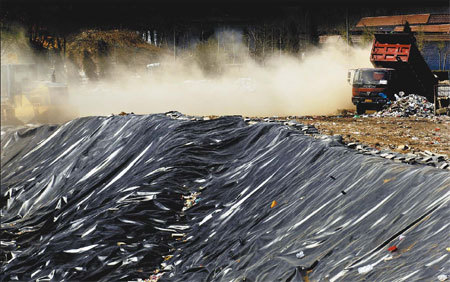Beijing is heading for garbage overload. Its 23 existing waste treatment plants are already working above capacity and trash piles are expanding by 8 percent every year.
The municipal government announced last week it would add another 17 plants by 2015, but experts have warned it could be too late as the capital will run out of landfill space within just four years.
 |
|
A landfill site near Liulitun, in west Beijing, one of the 23 waste treatment plants in the capital.
|
Official figures showed the city handled 6.72 million tons of domestic refuse last year, with 90 percent buried. But by 2012, local authorities estimate it will be 9.14 million tons.
All 13 major landfill sites are already overloaded, leading to fears of wastewater or toxic gas leaks, and are expanding by about 33 hectares a year. A further 1,000 small dumps are also scattered across the city.
Nor is the capital an isolated case. A report by the Ministry of Housing and Urban-Rural Development last year stated more than a third of Chinese cities are facing a crisis.
The annual urban waste per capita is now 220 kg, with 7 billion tons already on disposal sites covering 150,000 hectares across 665 cities.
The largest landfill site in Guangzhou, capital of Guangdong province, now handles more than three times its designed capacity. In Shanghai, another major metropolis, the amount of garbage generated in 2007 could have been piled five times higher than the city's Jinmao Tower, the third tallest building in the world.
"Beijing is facing a grave challenge in treating its garbage," stated a report delivered by Beijing's Deputy Mayor Huang Wei to the standing committee of the Beijing People's Congress at the weekend. "With rapid urbanization, industrialization and modernization, the city's urgent task is to enhance full-scale garbage treatment and recycling work."
In the face of a national crisis, incineration plants are being touted as the only solution to a growing problem. But it is a solution that has divided opinions among environmental experts, citizens and officials.
"All Beijing's landfills are jammed and causing pollution problems," said Chen Yong, director of Beijing Municipal Management Administration. "Before they fill up, we must find a solution. We need to adopt waste incineration as soon as possible."
Professor Nie Yongfeng, 64, of the college of environmental sciences and engineering at Tsinghua University in Beijing, agreed. He has been researching the treatment of urban solid waste for 20 years and strongly advocates the adoption of incineration.
"Incineration can significantly reduce the volume of the original waste up to 96 percent. It is the only practical way at present to curb the crisis," he said. "Incineration technology has become mature and safe, and has been adopted in many developed countries for more than four decades. The incinerator plant is an ideal waste-to-energy facility that generate renewable electricity or heat."
China lags far behind the likes of Japan and the United States, where 90 percent and 30 percent respectively of all garbage is burned.
There are now 50 waste-fueled plants dotted across China but in Shanghai, the city with the nation's largest combustion facility, Jiangqiao, which handles around 1,500 tons of trash a day, just 15 percent of waste is burned. In Shenzhen, Guangdong province, where the first incinerator was opened in 1988, it is 40 percent.
Beijing has a dire shortage of incineration facilities, with more than 90 percent of its trash heading to landfill sites.
Bio-treatment, where refuse is transformed into fertilizer, is another method officials in the capital are keen to explore and, according to the report delivered at the weekend, the extra facilities will see the proportion of incineration, bio-treatment and landfill reach 2:3:5 in 2012 and 4:3:3 in 2015.
The use of incineration technology, however, is by no means a perfect tonic to the nation's ills.
On April 11, hundreds of Shanghai residents marched in protest over a possible expansion of the Jiangqiao plant, while in Beijing plans to build five waste-fueled plants proposed in 2003 were all suspended following demonstrations by people living close to the proposed construction sites.
The capital's only working incinerator, which cost 750 million yuan ($110 million) and opened on the Gaoantun plant in Chaoyang district last July, has also come under close public scrutiny.
The Gaoantun landfill facility was built in 2002 and designed to handle 1,000 tons of garbage a day. By 2008, it was receiving around 4,000 tons of household waste a day, almost a quarter of the total daily trash generated in Beijing.
It uses a plastic anti-leakage method and is fitted with pipes to extract emissions, but the overloaded pit generated so much methane that inspections found 40 percent was escaping into the air. The resulting stink could be smelled more than 10 km away, affecting almost 200,000 residents.